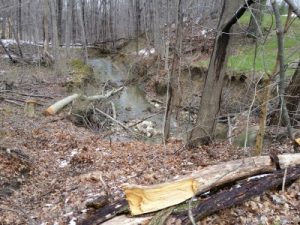
Before: Severe streambank erosion and poor floodplain access.

After: Natural channel design with contoured banks,
in-stream grade control riffles, and riparian plantings.

Before: Incised streambank with concrete blocks
and poor riparian cover.

After: Streambank stabilized using natural
bio-engineering approach.
Deer Creek/Bully Brook Stream & Wetland Restoration
Chagrin River Watershed Partners restored a wetland and two streams in 2017, partnering with Cleveland Metroparks at Manakiki Golf Course in the City of Willoughby Hills and the City of Wickliffe at Green Ridge Golf Course to demonstrate how recreation and restoration go hand in hand. We received $178,000 in funding from the USEPA Great Lakes Restoration Initiative to improve water quality in the Deer Creek/Gully Brook watershed, which drains to the Chagrin River. By reducing flooding and erosion issues, this project not only improves water quality and habitat, but leads to less maintenance issues at the golf course. This means more enjoyable playtime for everyone!
Manakiki Gold Course Wetland & Stream Restoration:
The 40,000 square-foot pond at Cleveland Metroparks Manakiki Golf Course was originally created by damming Gully Brook. Over time the pond trapped excessive sediment and reduced the pond’s water storage capacity. The pond flooded part of the golf course during heavy rain events unless the pond outlet was opened by maintenance staff beforehand. The stream was culverted downstream of the pond and disconnected from its former floodplain, leading to channel widening and severely eroding banks. To restore this area to a more natural, self-regulating hydrology, Chagrin River Watershed Partners hired a contractor to strategically excavate and grade the pond and streambanks, install bioengineered bank treatments, construct pool-riffle habitat in the stream, and heavily plant the area with native plants.
The former pond, now a wetland, has multiple zones including a wetland edge along the perimeter planted with various native sedges, rushes, and forbs; transition zones; and deep-water pool areas. A small channel meanders through the wetland complex and flows to the old pond outlet that was modified to allow for permanent flow. The contractor planted a native seed mix and plugs throughout the wetland complex. These plants filter out nutrients and sediment and provide food and habitat for songbirds, aquatic invertebrates, and pollinators like bees and butterflies. The restored wetland provides increased water storage capacity and alleviates flooding on the course.
Chagrin River Watershed Partners, Inc. received financial support in the amount of $178,479 from the U.S. EPA through the Great Lakes Restoration Initiative to complete this project.




